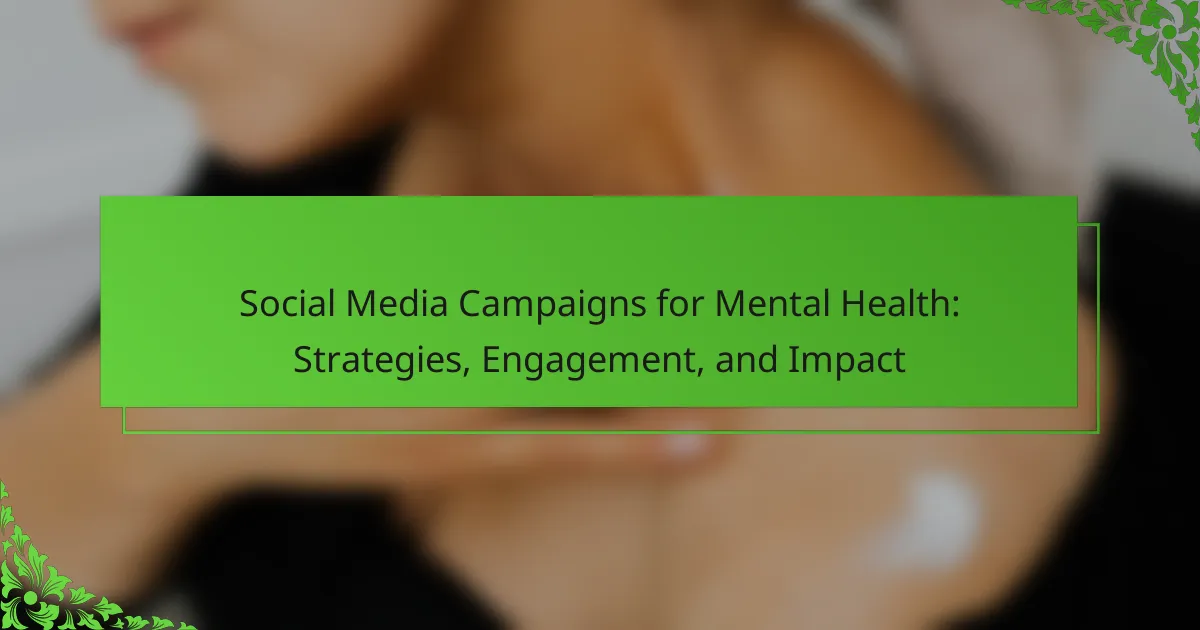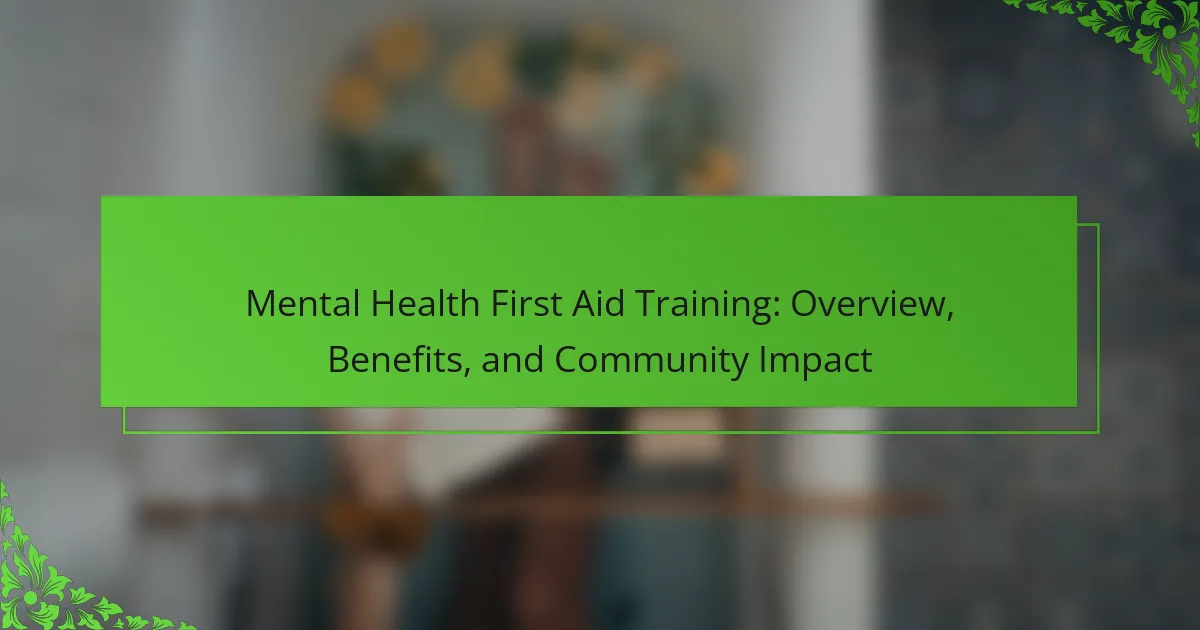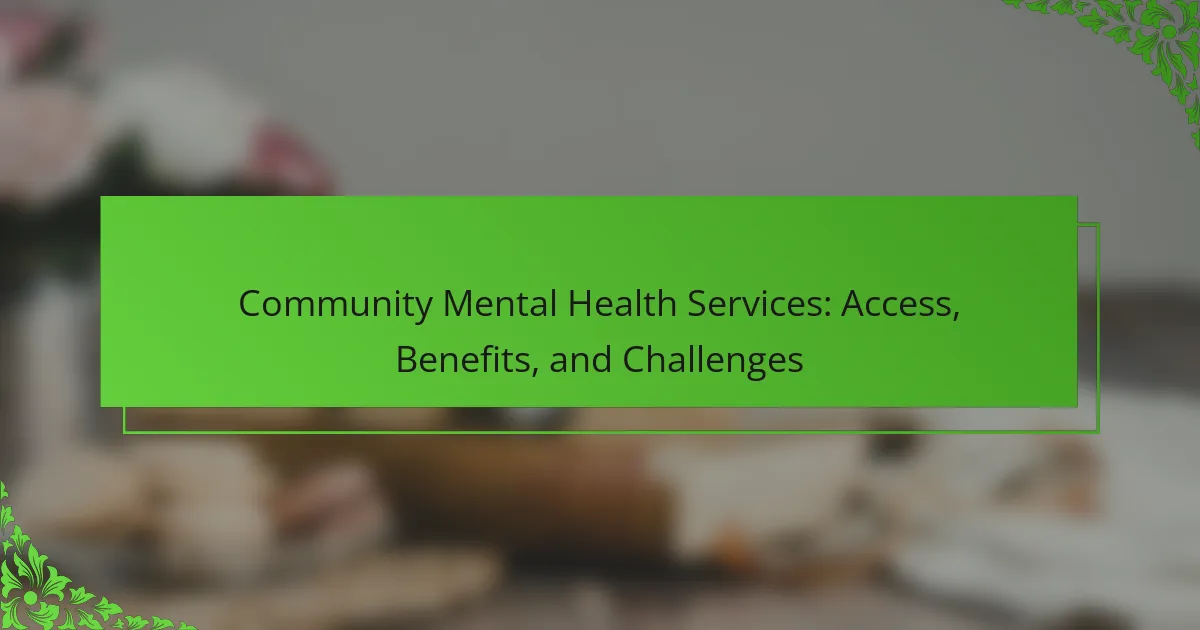Social media campaigns for mental health can significantly enhance awareness and reduce stigma. Effective strategies include clear messaging, community engagement, and collaboration with professionals. Engagement metrics like likes and shares measure impact, while authenticity and targeted content foster deeper connections. Addressing challenges such as misinformation is crucial for maximizing campaign effectiveness.

What are the key strategies for effective social media campaigns focused on mental health?
Effective social media campaigns for mental health focus on clear messaging, community engagement, and evidence-based content. Key strategies include leveraging personal stories to foster connection, utilizing data-driven insights to inform content, and promoting interactive elements like polls or Q&A sessions to enhance participation. Collaborating with mental health professionals ensures credibility, while consistent branding reinforces the campaign’s identity. Measuring engagement metrics helps refine strategies and maximize impact.
How do different platforms influence campaign strategy?
Different platforms significantly shape social media campaign strategies for mental health by influencing audience reach, engagement methods, and content formats. For instance, Instagram’s visual focus promotes storytelling, while Twitter’s brevity encourages concise messaging. Each platform’s unique attributes dictate how campaigns resonate with target demographics, affecting overall impact and effectiveness. Understanding these nuances allows for tailored approaches that enhance engagement and foster community support.
Which messaging techniques resonate most with audiences?
Emotional storytelling and relatable content resonate most with audiences in social media campaigns for mental health. These techniques foster connection and empathy, encouraging engagement and sharing. Visual content, such as infographics and videos, enhances message retention and impact. Additionally, user-generated content creates authenticity and community, strengthening the campaign’s reach.
What role do visuals play in mental health campaigns?
Visuals play a crucial role in mental health campaigns by enhancing engagement and conveying messages effectively. They can evoke emotions, simplify complex information, and create a relatable context. For instance, infographics can present statistics about mental health, making data more digestible. Imagery can also foster community and connection, encouraging individuals to share their experiences. A study found that posts with visuals receive 94% more views than those without. This highlights the importance of integrating strong visual elements in social media strategies for maximizing impact.
How can storytelling enhance engagement in campaigns?
Storytelling enhances engagement in campaigns by creating emotional connections and making complex issues relatable. It captivates audiences, fostering empathy and understanding. Effective narratives encourage sharing and interaction, amplifying the campaign’s reach. For mental health, personal stories can destigmatize experiences, promoting awareness and support.

How can engagement be measured in social media mental health campaigns?
Engagement in social media mental health campaigns can be measured through metrics such as likes, shares, comments, and reach. These indicators provide insight into audience interaction and campaign effectiveness. Additionally, tracking engagement rates over time helps assess the impact of specific strategies. Analyzing qualitative feedback can also reveal deeper emotional connections and community support.
What metrics are most relevant for assessing impact?
Engagement metrics are most relevant for assessing the impact of social media campaigns for mental health. Key metrics include reach, impressions, shares, comments, and likes. These metrics reflect audience interaction and can indicate campaign effectiveness.
| Metric | Description | Importance |
|—————-|———————————–|————————————-|
| Reach | Total unique users exposed | Measures awareness |
| Impressions | Total views of content | Indicates visibility |
| Shares | Content shared by users | Shows endorsement and engagement |
| Comments | User feedback and discussions | Reflects depth of engagement |
| Likes | Positive reactions to content | Indicates approval and interest |
How can audience feedback shape campaign effectiveness?
Audience feedback significantly enhances campaign effectiveness by providing insights into public perception and engagement. It allows for real-time adjustments to messaging and strategies, ensuring that content resonates. Analyzing feedback helps identify successful elements and areas needing improvement, fostering a more impactful connection with the audience. Engaging with feedback can also build community trust and encourage participation, ultimately leading to greater campaign success.
Which tools are best for tracking social media engagement?
The best tools for tracking social media engagement include Hootsuite, Sprout Social, Buffer, and Google Analytics. These platforms provide metrics like likes, shares, comments, and overall reach, essential for evaluating campaign effectiveness. Hootsuite excels in scheduling and monitoring multiple accounts, while Sprout Social offers robust analytics and reporting features. Buffer is user-friendly for small businesses, and Google Analytics integrates website traffic with social media performance. Each tool has unique attributes that cater to different engagement tracking needs.
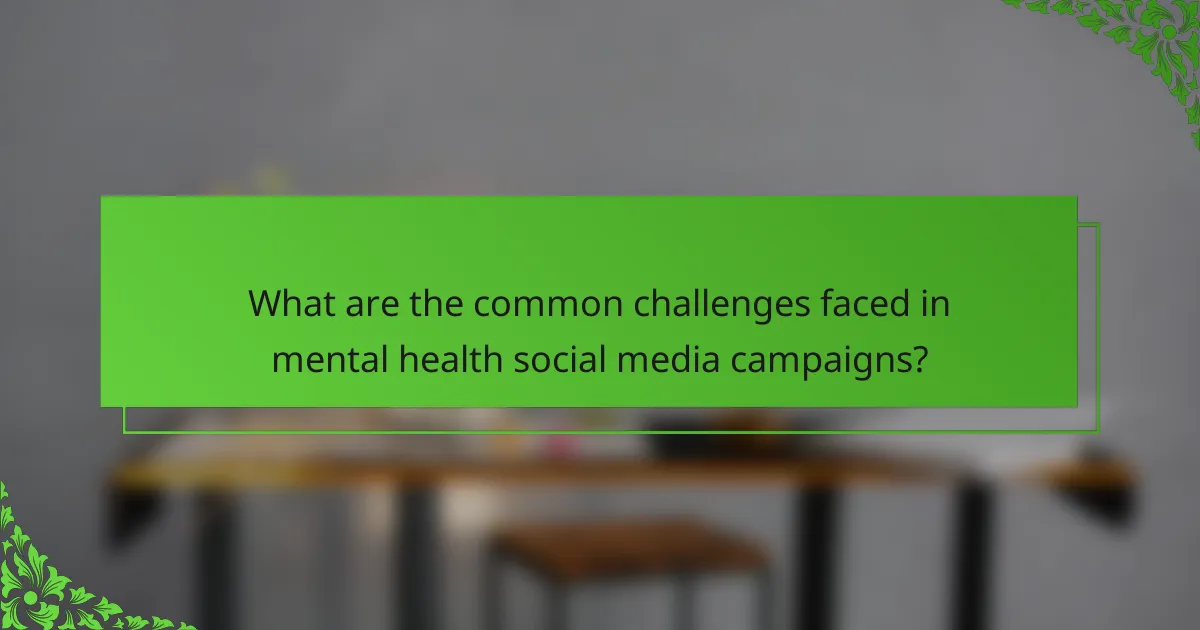
What are the common challenges faced in mental health social media campaigns?
Social media campaigns for mental health often face challenges such as stigma, misinformation, and audience engagement. Stigma can deter individuals from participating in discussions. Misinformation spreads quickly, undermining trust in campaigns. Engaging diverse audiences requires tailored content strategies. Additionally, measuring the impact of campaigns poses difficulties in demonstrating effectiveness.
How can stigma affect campaign outreach?
Stigma can significantly hinder campaign outreach by creating barriers to engagement and acceptance. It often leads to misinformation and fear, discouraging individuals from participating in mental health initiatives. Campaigns that address stigma directly can foster a more inclusive environment, enhancing their effectiveness. For instance, using relatable narratives and testimonials can help normalize discussions around mental health, ultimately increasing outreach success.
What are the risks of misinformation in mental health messaging?
Misinformation in mental health messaging can lead to stigma, misunderstanding, and ineffective treatment. It may cause individuals to avoid seeking help or following proper guidance. Accurate information is crucial for promoting mental well-being and encouraging open discussions. Social media campaigns must prioritize factual content to mitigate these risks and enhance public understanding.
How can campaigns ensure inclusivity and accessibility?
Campaigns can ensure inclusivity and accessibility by adopting diverse strategies. First, utilize multiple platforms to reach varied demographics. Second, incorporate accessible design features, such as alt text for images and captions for videos. Third, engage with communities to understand their specific needs. Lastly, provide resources in multiple languages to accommodate non-native speakers. These approaches enhance participation and representation, fostering a supportive environment for mental health discussions.
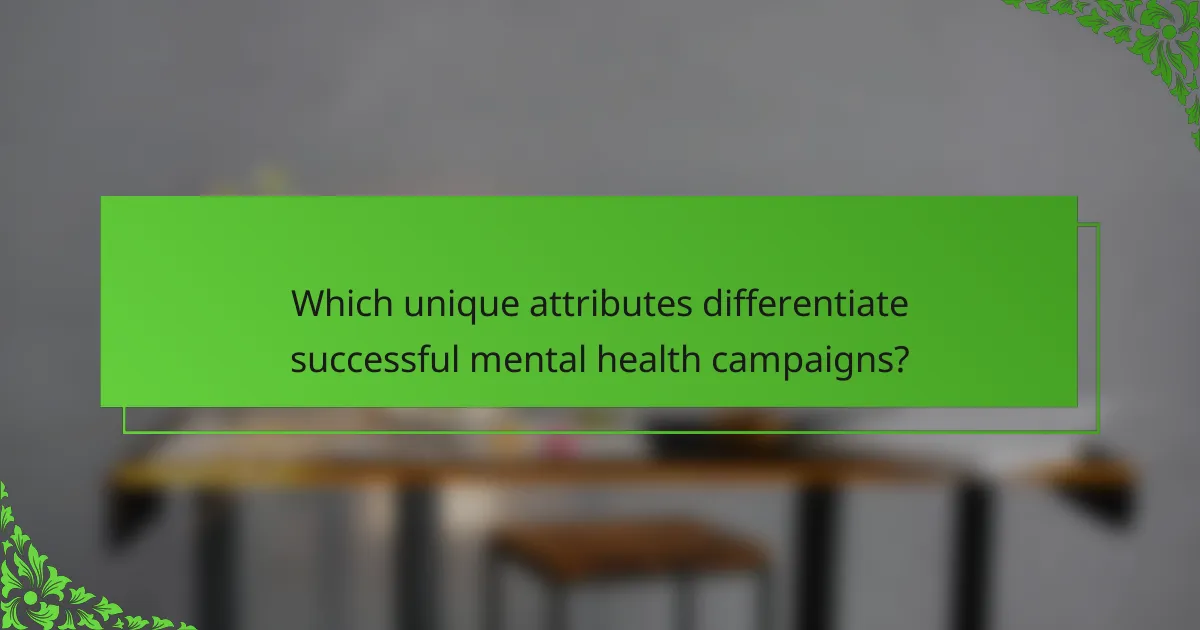
Which unique attributes differentiate successful mental health campaigns?
Successful mental health campaigns often feature unique attributes such as authenticity, community involvement, and targeted messaging. Authenticity builds trust, while community involvement fosters engagement. Targeted messaging ensures relevance to specific demographics, enhancing the campaign’s impact.
How do cultural nuances impact campaign messaging?
Cultural nuances significantly influence campaign messaging for mental health on social media. Understanding local values, beliefs, and communication styles enhances engagement and effectiveness. Tailoring messages to reflect cultural sensitivities fosters trust and encourages participation. For example, imagery or language that resonates with specific communities can lead to increased interaction and support. Additionally, addressing cultural stigma surrounding mental health can create a more inclusive environment, promoting awareness and understanding. Adapting strategies based on cultural context ultimately enhances the impact of mental health campaigns.
What innovative formats have emerged in recent campaigns?
Innovative formats in recent social media campaigns for mental health include interactive storytelling, live Q&A sessions, and user-generated content challenges. These formats enhance engagement and foster community support. For instance, interactive storytelling allows users to share personal experiences, increasing relatability. Live Q&A sessions provide real-time support from mental health professionals, creating immediate connections. User-generated content challenges encourage participation, empowering individuals to express their journeys. These strategies significantly impact awareness and reduce stigma surrounding mental health.
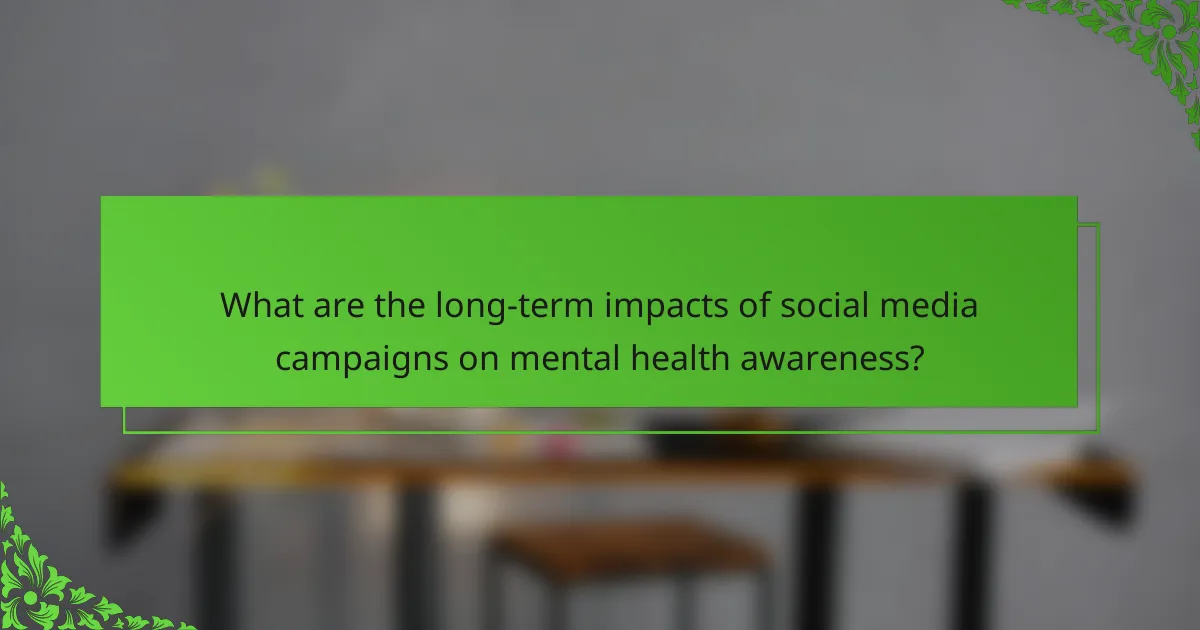
What are the long-term impacts of social media campaigns on mental health awareness?
Social media campaigns significantly enhance long-term mental health awareness by fostering community support and reducing stigma. These campaigns create ongoing conversations around mental health, leading to increased help-seeking behavior. Research shows that sustained engagement through social media can lead to lasting changes in public attitudes towards mental health, promoting understanding and empathy. Furthermore, these campaigns often utilize relatable content, which resonates with diverse audiences, ensuring broader reach and impact.
How do campaigns contribute to changing societal perceptions of mental health?
Social media campaigns significantly shift societal perceptions of mental health by fostering awareness and reducing stigma. These campaigns utilize relatable content and personal stories to engage audiences effectively. For instance, the hashtag movements like #MentalHealthAwareness encourage open conversations, making mental health issues more visible. As a result, increased visibility leads to greater understanding and acceptance, which can positively influence public attitudes. Engaging visuals and interactive elements further enhance participation, ensuring that mental health is recognized as a vital aspect of overall well-being.
What role do partnerships with mental health organizations play?
Partnerships with mental health organizations enhance social media campaigns by providing expertise and resources. They help ensure accurate messaging and increase credibility. Collaborations often lead to broader reach and improved engagement, fostering community support and awareness. These partnerships can also facilitate access to mental health resources and services, addressing unique needs within diverse populations.
How can campaigns foster community support and connection?
Social media campaigns can effectively foster community support and connection by promoting shared experiences and facilitating open dialogues. Engaging storytelling can resonate with audiences, encouraging participation and empathy. Utilizing interactive elements, such as polls or live Q&A sessions, enhances connection and involvement. Collaborating with mental health advocates can also amplify the campaign’s reach, creating a sense of belonging among participants. Consistent messaging around mental health awareness reinforces community ties, helping individuals feel supported and understood.
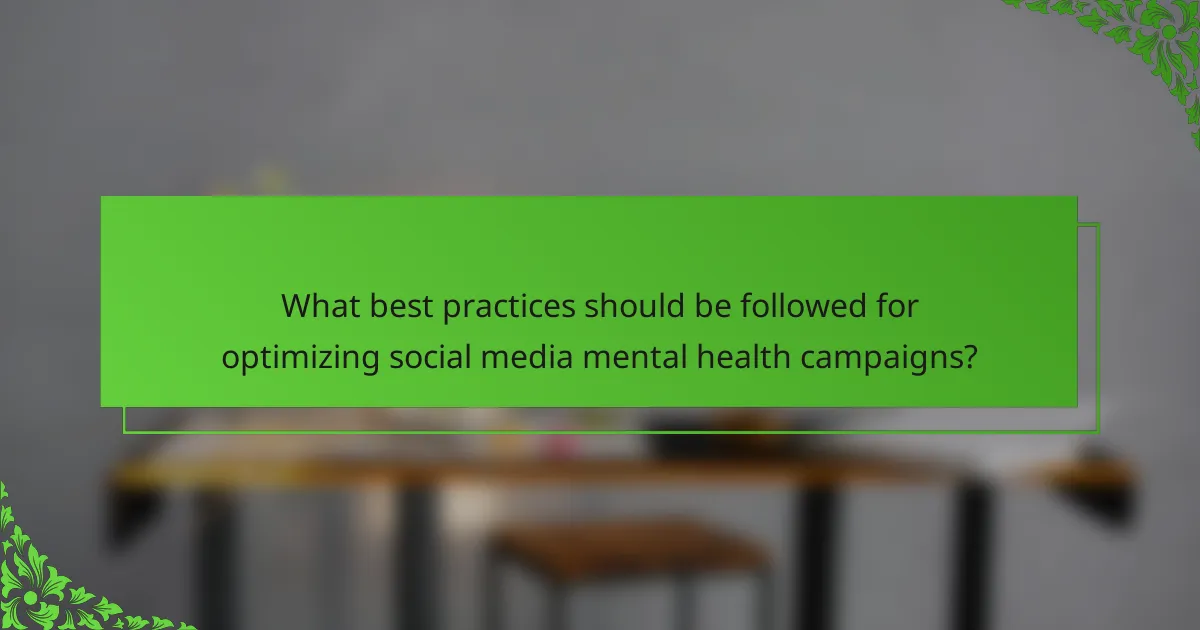
What best practices should be followed for optimizing social media mental health campaigns?
To optimize social media mental health campaigns, prioritize authenticity, engagement, and targeted messaging. Focus on creating relatable content that resonates with your audience. Use data analytics to tailor your approach based on audience preferences and behaviors.
1. Establish clear objectives to guide campaign direction.
2. Utilize various formats, such as videos and infographics, to enhance engagement.
3. Foster community interaction by encouraging user-generated content.
4. Monitor and respond to feedback promptly to build trust.
5. Collaborate with mental health professionals to ensure accurate messaging.
6. Measure campaign impact through analytics to refine future strategies.
Which common mistakes should be avoided in campaign execution?
To ensure effective execution of social media campaigns for mental health, avoid common mistakes such as lack of clear objectives, insufficient audience research, inconsistent messaging, and neglecting engagement metrics. These pitfalls can hinder campaign impact and outreach. Focus on setting measurable goals, understanding your audience’s needs, maintaining a unified message, and regularly analyzing engagement data to refine strategies.
How can campaigns be adapted for different demographic audiences?
Campaigns can be adapted for different demographic audiences by tailoring messaging and content to their specific needs. Understanding age, cultural background, and interests helps create relevant mental health campaigns. For instance, younger audiences may prefer visual content on platforms like Instagram, while older demographics might engage more with informative articles on Facebook.
Additionally, using language and themes that resonate with each group enhances connection. Data shows that campaigns addressing specific mental health issues relevant to a demographic can increase engagement by up to 50%.
Incorporating feedback from target audiences ensures campaigns remain effective and relatable. Regularly analyzing engagement metrics helps refine strategies for better impact across diverse groups.
What are the benefits of continuous learning and adaptation in campaign strategies?
Continuous learning and adaptation in campaign strategies enhance effectiveness and relevance. These practices enable campaigns to respond to changing audience needs and emerging trends. Regularly analyzing engagement metrics allows for timely adjustments, optimizing resource allocation. Adapting strategies fosters innovation, ensuring that mental health campaigns remain impactful and resonate with diverse communities. This iterative process builds trust and strengthens connections with the audience, ultimately enhancing the campaign’s overall success.
